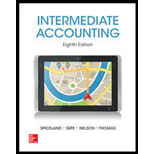
Concept explainers
A)
Lessee guaranteed residual value
The lessee guaranteed residual value of leased asset is an estimation of the commercial value of the asset at the end of lease term. The present value is considered when determining the lease classification criteria (Criteria 4). Lessee guaranteed residual value is added to lease receivable and also added to sales revenue.
To Determine: the amounts at the beginning of lease for the lessor at each independent situation.
A)
Explanation of Solution
| Situation | ||||
| 1 | 2 | 3 | 4 | |
| Lessor | ||||
| Minimum Lease payments | (1)400,000 | (2) 553,000 | (3) 640,000 | (4) 510,000 |
| Gross investment in the lease |
(5)430,000 | (6) 553,000 | (7) 675,000 | (8) 550,000 |
| Net investment in the lease |
(9)369,175 | (10) 433,809 | (11) 533,685 | (12) 451,137 |
| Sales revenue | (13)348,685 | (14)433,809 | (15) 512,816 | (16) 423,817 |
| Cost of goods sold | (17)348,685 | (18)449,896 | (19) 479,131 | (20) 372,680 |
| Dealers profit | (21) $0 | (22)$(16,087) | (23) $33,685 | (24) $51,137 |
Table (1)
Working note:
The lease payment is calculated as follows:
The gross investment in lease is calculated as follows:
The net investment in the lease is calculated as follows:
Sales revenue is calculated as follows:
Cost of goods sold is calculated as follows:
Dealers profit is calculated as follows:
(B)
the amounts at the beginning of lease for the lessee at each independent situation.
(B)
Explanation of Solution
| Situation | ||||
| 1 | 2 | 3 | 4 | |
| Lessee | ||||
| Lease payments | (25) 400,000 | (26) 553,000 | (27) 640,000 | (28) 460,000 |
| Leased asset | (29) 353,129 | (30) 449,896 | (31) 512,816 | (32) 389,666 |
| Lease payable | (29) 353,129 | (30) 449,896 | (31) 512,816 | (32) 389,666 |
Table (2)
The lease payment is calculated as follows:
The amount to be recorded as leased asset and lease liability is calculated as follows:
Note:
Present value of the minimum lease payments and leased asset is calculated based on the discounted rates at lower of lessor and lessee.
Want to see more full solutions like this?
Chapter 15 Solutions
INTERMEDIATE ACCOUNTING WITH AIR FRANCE-KLM 2013 ANNUAL REPORT
- no chatgpAccumulated Depreciation will appear as a deduction within the section of the balance sheet labeled as Property, Plant and Equipment. True Falsearrow_forwardNo ai Depreciation Expense is shown on the income statement in order to achieve accounting's matching principle. True Falsearrow_forwardno aiOne company might depreciate a new computer over three years while another company might depreciate the same model computer over five years...and both companies are right. True Falsearrow_forward
- no ai An asset's useful life is the same as its physical life? True Falsearrow_forwardno ai Depreciation Expense reflects an allocation of an asset's original cost rather than an allocation based on the economic value that is being consumed. True Falsearrow_forwardThe purpose of depreciation is to have the balance sheet report the current value of an asset. True Falsearrow_forward

 AccountingAccountingISBN:9781337272094Author:WARREN, Carl S., Reeve, James M., Duchac, Jonathan E.Publisher:Cengage Learning,
AccountingAccountingISBN:9781337272094Author:WARREN, Carl S., Reeve, James M., Duchac, Jonathan E.Publisher:Cengage Learning, Accounting Information SystemsAccountingISBN:9781337619202Author:Hall, James A.Publisher:Cengage Learning,
Accounting Information SystemsAccountingISBN:9781337619202Author:Hall, James A.Publisher:Cengage Learning, Horngren's Cost Accounting: A Managerial Emphasis...AccountingISBN:9780134475585Author:Srikant M. Datar, Madhav V. RajanPublisher:PEARSON
Horngren's Cost Accounting: A Managerial Emphasis...AccountingISBN:9780134475585Author:Srikant M. Datar, Madhav V. RajanPublisher:PEARSON Intermediate AccountingAccountingISBN:9781259722660Author:J. David Spiceland, Mark W. Nelson, Wayne M ThomasPublisher:McGraw-Hill Education
Intermediate AccountingAccountingISBN:9781259722660Author:J. David Spiceland, Mark W. Nelson, Wayne M ThomasPublisher:McGraw-Hill Education Financial and Managerial AccountingAccountingISBN:9781259726705Author:John J Wild, Ken W. Shaw, Barbara Chiappetta Fundamental Accounting PrinciplesPublisher:McGraw-Hill Education
Financial and Managerial AccountingAccountingISBN:9781259726705Author:John J Wild, Ken W. Shaw, Barbara Chiappetta Fundamental Accounting PrinciplesPublisher:McGraw-Hill Education





